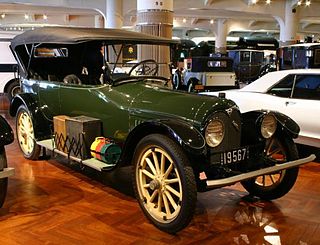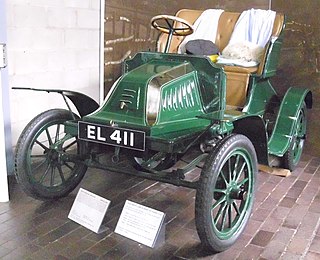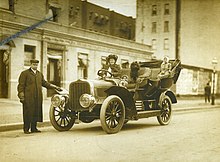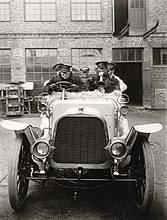
The Overland Automobile Company was an American automobile manufacturer in Toledo, Ohio. It was the founding company of Willys-Overland and one of the earliest mass producers of automobiles.

The Brass Era is an American term for the early period of automotive manufacturing, named for the prominent brass fittings used during this time for such things as lights and radiators. It is generally considered to encompass 1896 through 1915, a time when these vehicles were often referred to as horseless carriages.

The Acme was a make of American automobiles made in Reading, Pennsylvania from 1903 to 1911. They were the successor of the Reber which was made from 1902 to 1903 by Reber Manufacturing.

The Apperson was a brand of American automobile manufactured from 1901 to 1926 in Kokomo, Indiana.

L'Aster, Aster, Ateliers de Construction Mecanique l'Aster, was a French manufacturer of automobiles and the leading supplier of engines to other manufacturers from the late 1890s until circa 1910/12. Although primarily known as an engine mass manufacturer the company also produced chassis for coach-works and a complete range of components.

Haynes-Apperson Company was a manufacturer of Brass Era automobiles in Kokomo, Indiana, from 1896 to 1905. It was the first automobile manufacturer in Indiana, and among the first in the United States. Elwood Haynes, one of the founders, worked on early types of stainless steel and was the inventor of stellite, and many of the early advances in automobile technology were first invented by the company.

The Knox Automobile Company was a manufacturer of automobiles in Springfield, Massachusetts, United States, between 1900 and 1914. Knox also built trucks and farm tractors until 1924. They are notable for building the very first modern fire engine in 1905.

The Premier Motor Manufacturing Company was organized in 1903 by George A. Weidely and Harold O. Smith in Indianapolis, Indiana. The company built automobiles with air-cooled engines.

The first Cadillac automobiles were the 1903 Model built in the last quarter of 1902. These were 2-seater "horseless carriages" powered by a reliable and sturdy 10 hp (7 kW) single-cylinder engine developed by Henry Martyn Leland and built by Leland and Faulconer Manufacturing Company of Detroit, of which Henry Leland was founder, vice-president and general manager.

Columbia was an American brand of automobiles produced by a group of companies in the United States. They included the Pope Manufacturing Company of Hartford, Connecticut, the Electric Vehicle Company, and an entity of brief existence in 1899, the Columbia Automobile Company.
F. B. Stearns and Company, later known as F.B. Stearns Company was an American manufacturer of luxury cars in Cleveland, Ohio marketed under the brand names Stearns from 1900 to 1911 then Stearns-Knight from 1911 until 1929.

The Brew-Hatcher or B & H was an American automobile introduced in January 1904 at the Chicago Automobile Show and manufactured from 1904 until 1905.

The original Ford Model A is the first car produced by the Ford Motor Company, beginning production in 1903. Ernest Pfennig, a Chicago dentist, became the first owner of a Model A on July 23, 1903; 1,750 cars were made from 1903 through 1904 during Ford's occupancy of its first facility: the Ford Mack Avenue Plant, a modest rented wood-frame building on Detroit's East Side. The Model A was replaced by the Ford Model C during 1904 with some sales overlap.

The Union automobile was a vehicle manufactured by the Union Automobile Company from 1902 until 1905. It was designed by John William Lambert, who had developed the three-wheel Buckeye gasoline buggy in 1891. Over the next decade, Lambert substantially refined the vehicle, with modifications including an additional wheel, a more powerful engine, and a new transmission system. The Union Automobile Company was formed as a subsidiary of Lambert's Buckeye Manufacturing Company solely to manufacture the Union, which took its name from Union City, Indiana, the city where it was built and which endorsed its production. In total, the company built over three hundred Union automobiles, before development shifted to the Lambert automobile, the Union's successor.

The Lambert automobile and Lambert truck were vehicles built from 1905 through 1916 by the Lambert Automobile Company in Anderson, Indiana, United States. The Lambert automobile was an outgrowth from the Union automobile made by the Union Automobile Company, a previous vehicle that was being manufactured by John William Lambert. The factory manufactured about 3,000 automobiles and trucks per year by 1915 and had several models ranging in price from $1,200 to $3,000 at the time. The vehicles came with a gearless friction drive transmission. The demise of the manufacture of automobiles and trucks came about because of World War I.

The Glide automobile was an American automobile manufactured by the Bartholomew Company in Peoria Heights, Illinois beginning in 1902. Founded by John B. Bartholomew, the company continued to produce automobiles until 1920, when the company began manufacturing trucks for the Avery Company, of which Bartholomew was also president.

The Union Automobile Company was an automobile factory to manufacture the Union automobile through the Buckeye Manufacturing Company. It began manufacturing automobiles in 1902 and produced them through 1905. The company was located in Union City, Indiana. The inventor of Union automobile gasoline engine and friction drive gearless transmission was John W. Lambert. In the early part of 1905 the company moved to Anderson, Indiana. It had produced 325 automobiles before going out of business in the later part of 1905. It was replaced with a redesigned model that became the Lambert automobile.

Pope-Tribune (1904–1908) was part of the Pope automobile group of companies founded by Colonel Albert Pope manufacturing Brass Era automobiles in Hagerstown, Maryland.
The Welch Motor Company was an American automobile company headquartered in Chelsea, Michigan. It started in 1901 and continued production of luxury vehicles until 1911 when it merged with General Motors.


























